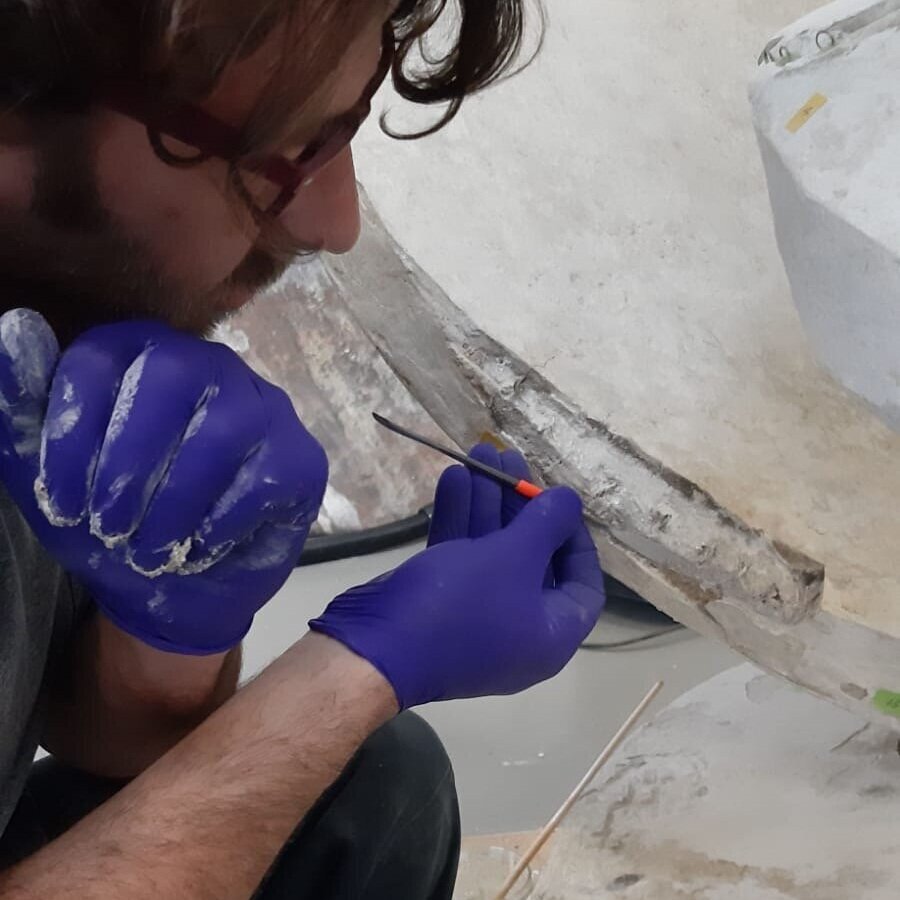Donald Judd - Untitled - Private Collection
Material - Concrete
Treatment of this work is featured in Getty Publication - Concrete: Case Studies in Conservation Practice Edited by Catherine Croft and Susan Macdonald with Gail Ostergren. Link.
The work after restoration.
Jamie Fairchild using Vortech abrasive system to clean the surface of the concrete.
The work mid-clean using Thermotec cleaning system.
Steve Honey masking the surfaces before re-applying the silicone.
The work in pieces before treatment.
Colour and aggregate matching the new ‘Peri-crete’.
Tessa remodelling sections of the figures.
Applying and re-modelling the ‘Peri-crete’ to areas of loss.
Tessa restoring the female figure.
Barbara Hepworth - Construction (Crucifixion): Homage to Mondrian - Salisbury Cathedral
The artwork after restoration. Photo credit Ash Mills.
The deteriorated paint and wax layer was removed using Thermotec.
Tessa applying hot wax to the cleaned metal surface.
The artwork after the removal of the paint and wax layer layer.
The majority of the original paint had significantly faded, however the previously UV protected paint surfaces revealed by the Thermotec treatment were used to colour match the restoration paint layers.
Kenneth Armitage - Richmond Oak
Artwork after restoration.
Steve removing the deteriorated paint layers from the bronze.
Applying the new paint layers.
Barbara Hepworth - Orpheus (Maquette 1) 1956.
Copper alloy and cotton string on a wooden base.
The original string was extremely fragile, had broken in three places, and was too weak to be put under the tension required to pull the metal into its intended form. The decision was made to carefully archive the original and replace it with a replica. The decision to replace the original is always a matter of great consideration. By analysing and recording the materials and methods of stringing, Tessa’s ongoing research into Hepworth’s strings (a collaboration between the studio, the Hepworth Estate, and University College London) is intended to be a useful guide for future conservators and art historians.
The work in the studio before treatment.
The work after treatment.
John Milne - Wave - Penwith Society of Arts.
Artwork after treatment, installed at the Penwith Gallery, St Ives. Image copy write Penwith Society of Arts.
The Wave before treatment.
Artwork during treatment. Distortion and de-lamination of glass fibre surface corrected with multiple clamps.
Phillip King - Sun and Moon and Sun’s Roots II
The work after treatment.
Tessa Jackson preparing the weld surface before in-painting the losses. The paint fragments seen in the tray will be carefully re-integrated into their original position.
Before and after treatment. The work arrived at the studio displaying evidence of a previous attempt at a structural repair. This previous intervention was removed, re-welded, and in-painted to visually re-integrate the area with the original sculpture.
After treatment (above), Before treatment (three images below). The paint was flaking and delaminating from the metal substrate in numerous places across the surface of the work. Detached fragments were re-located to their original position and re-adhered to the surface. Delaminating and distorted areas were consolidated and clamped into position. Losses were carefully filled and in-painted to return the work to the condition intended by the artist.
India Carpenter consolidating the lifting paint of Sun’s Roots II.
Paint Loss before treatment.
Paint loss filled and shaped.
Filled area in-painted to visually re-integrate.
Isa Genzken - Glass Sculpture
A small drop of adhesive is being applied to the base of a glass artwork by Isa Genzken.
Bill Woodrow - Swarm Sculpture
Tessa carefully cleaning the artwork.
A detail of the gilded bronze surface. A consolidation layer was applied to protect the surface and to regain the contrast between the dark bronze and gilded bees.
Barbara Hepworth - Polished Sculpture
A light clean of a polished Barbara Hepworth.
Barbara Hepworth - Turning Forms - Treatment in Progress
Turning Forms by Barbara Hepworth is a concrete sculpture, designed to be viewed on a slow rotation. The work was commissioned for the Festival of Britain and was later moved to St Julian’s School, St Albans (now the Marlborough Science Academy) in Hertfordshire in 1953.
Analysis and archival research have revealed that the sculpture was built over a complex armature using various layers of concrete. The surface was then built up using layers of white cement and aggregates.
The work is currently at the Jackson Sculpture Conservation Studio for conservation and restoration. This conservation is in collaboration with Hertfordshire County Council, The Hepworth Estate, The Twentieth Century Society, and other conservation specialists.
Archive image of the Turning Forms, photographed in Hepworth’s studio circa 1951. Image copy write Bowness.
Image of the armature of Turning Forms taken whilst the work was under construction circa 1951. Image copy write Bowness.
Turning Forms at the studio before treatment.
Stone conservator and concrete specialist Andy Coxall can be seen here using the Thermatech cleaning system to remove surface dirt from the work.
A thick layer of paint that had been applied over the original surface was removed using a solvent gel and a second application of the Thermatech.
This stage of the cleaning process has revealed the previous restorations and areas of damage, but most significantly, has revealed the intricate details of Hepworth’s original marks.
The image above is one of five condition maps, detailing the location of every loss, previous restoration, surface stain, and crack. By referring to archive images of the armature taken whilst the work was under construction, we can map its position, helping us to understand the work from both the inside and out.
A number of the larger losses required a multi-layer approach to consolidation and filling. Above is a detail of one of these areas, depicting the addition of stainless steel armature rings and a layer of vermiculite aggregate and cement fill.
Conservator and concrete specialist Andy Coxall can be seen here applying a layer of holme sand and snowcrete cement, gradually building up layers to consolidate and fill the large area of loss.













































